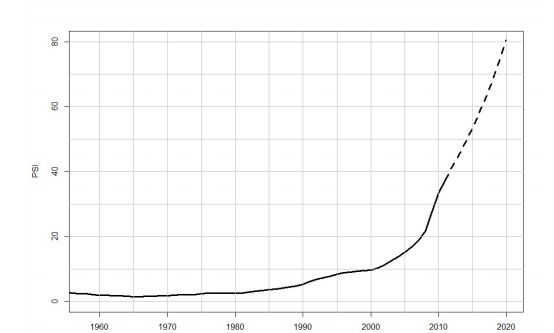Date: September 5, 2019
Author: Paul Cockshott
Since various economics professors noticed that Marxists had been publishing articles showing, from empirical data, that the labour theory of value was right[ 5,3,4,6,1 7,2 ], they have felt the need to come up with objections. Whilst in the past the objections economists raised to the labour theory of value were purely abstract and theoretical, now they had a harder job. They now had Marxists producing actual figures which they had to cast doubt on. The objections raised by economists then get relayed in a popularised form on blogs or social media debates. It is worth my while giving a brief rundown of the 3 favourite objections along with an explanation of why these are all groundless. We have refuted them all in the open literature but since the relevant paper is not well known here is a short informal account.
1 The objection from money
The first objection is to say that the Marxists have not demonstrated a correlation between exchange values and labour but only between wages and exchange value. This, it is argued is circular, money quantities are being used to explain value not quantities of labour. This objection is simply false. Zachariah[6] used Swedish I/O tables that contain data on the number of person-years used in each industry there and obtained a correlation of 96.5% between integrated labour contents and market values of industrial output. We[2 ] used UK I/O tables which have total wage bills for each industry along with other statistics on average hourly wages for each industry to do a similar correlation between hours directly and indirectly used in each industry and market values of outputs and obtained a 96.4% correlation. So it has been demonstrated that if you start out from actual hours worked you get a very strong correlation between price and labour value.
2 The objection from social necessity
Another objection that economists raise is to say: ‘Marx said it was socially necessary labour time that determines value, but the empirical studies just take clock time not socially necessary time’. This objection shows that some economists do not understand how Marx defined socially necessary labour time: The labour, however, that forms the substance of value, is homogeneous human labour, expenditure of one uniform labour power. The total labour power of society, which is embodied in the sum total of the values of all commodities produced by that society, counts here as one homogeneous mass of human labour power, composed though it be of innumerable individual units. Each of these units is the same as any other, so far as it has the character of the average labour power of society, and takes effect as such; that is, so far as it requires for producing a commodity, no more time than is needed on an average, no more than is socially necessary. The labour time socially necessary is that required to produce an article under the normal conditions of production, and with the average degree of skill and intensity prevalent at the time.We see then that that which determines the magnitude of the value of any article is the amount of labour socially necessary, or the labour time socially necessary for its production. Each individual commodity, in this connexion, is to be considered as an average sample of its class. He is explicit that the socially necessary time that creates value is the average time that it takes to make a commodity of a given class. So the socially necessary time to produce 1Kwh of electricity is the average time used across all power plants active on the grid. Or expressed in money, the socially necessary time to produce £1 of electricity is the average time spent to produce £1 of electricity across all power plants weighted by the amount of electricity each plant produced. Now the empirical studies use, for each industry, the total labour required to produce the output of the industry. So for the electricity, they give the total hours of labour to produce the total sales of electricity for the year. But by definition, this total is equal to the average labour content multiplied by the number of units produced. So the empirical studies are strictly and exactly using the Marxian definition of socially necessary labour in the calculations.
3 The objection from size
Another objection is that the observed correlations are a spurious side effect of industry sizes. For a third factor to be the common cause of the variation in the two vectors of interest, that third factor must itself be quantifiable. How do you measure industry size? Is it defined in money terms? Is it defined in employment terms? We can intuitively see that ‘big’ industries employ more people and ‘big’ industries have a larger money output. But employment and money output are the two variables being taken as data by the empirical studies. What they are demonstrating is that the money turnover of the industry is 96% explained by the direct plus indirect employment of labour by the industry. So ‘size’ defined in either money or employment terms is not a third factor that could be causing the spurious correlation. One could, of course, use some physical definition of size, output in Kg or land area occupied. But none of the economists has attempted to use such physical measures of size to show that weight of output or land area used is the ‘size’ that is causing the spurious correlation. Of course, as soon as you try to think of some such physical measure it becomes obvious that the task will be hopeless. There will only be a relatively weak correlation between the weights of the output of industries and their money output or employment, the same for land use.
References
1 Nils Fröhlich, “Labour values, prices of production and the missing equalisation tendency of profit rates: evidence from the German economy“, Cambridge Journal of Economics 37, 5 (2013), pp. 1107–1126. 2 G. Michaelson, W. P. Cockshott, and A. F. Cottrell, “Testing Marx: some new results from UK data“, Capital and Class (1995), pp. 103–129. 3 E. M. Ochoa, “Values, prices, and wage–profit curves in the US economy“, Cambridge Journal of Economics 13 (1989), pp. 413–29. 4 P. Petrovic, “The deviation of production prices from labour values: some methodology and empirical evidence“, Cambridge Journal of Economics 11 (1987), pp. 197–210. 5 A. M. Shaikh, “The empirical strength of the labour theory of value“, in Marxian Economics: A Reappraisal vol. 2, (Macmillan, 1998), pp. 225–251. 6 David Zachariah, “Testing the labour theory of value in Sweden” (2004). 7 David Zachariah, “Labour Value and Equalisation of Profit Rates“, Indian Development Review 4, 1 (2006), pp. 1–21.

